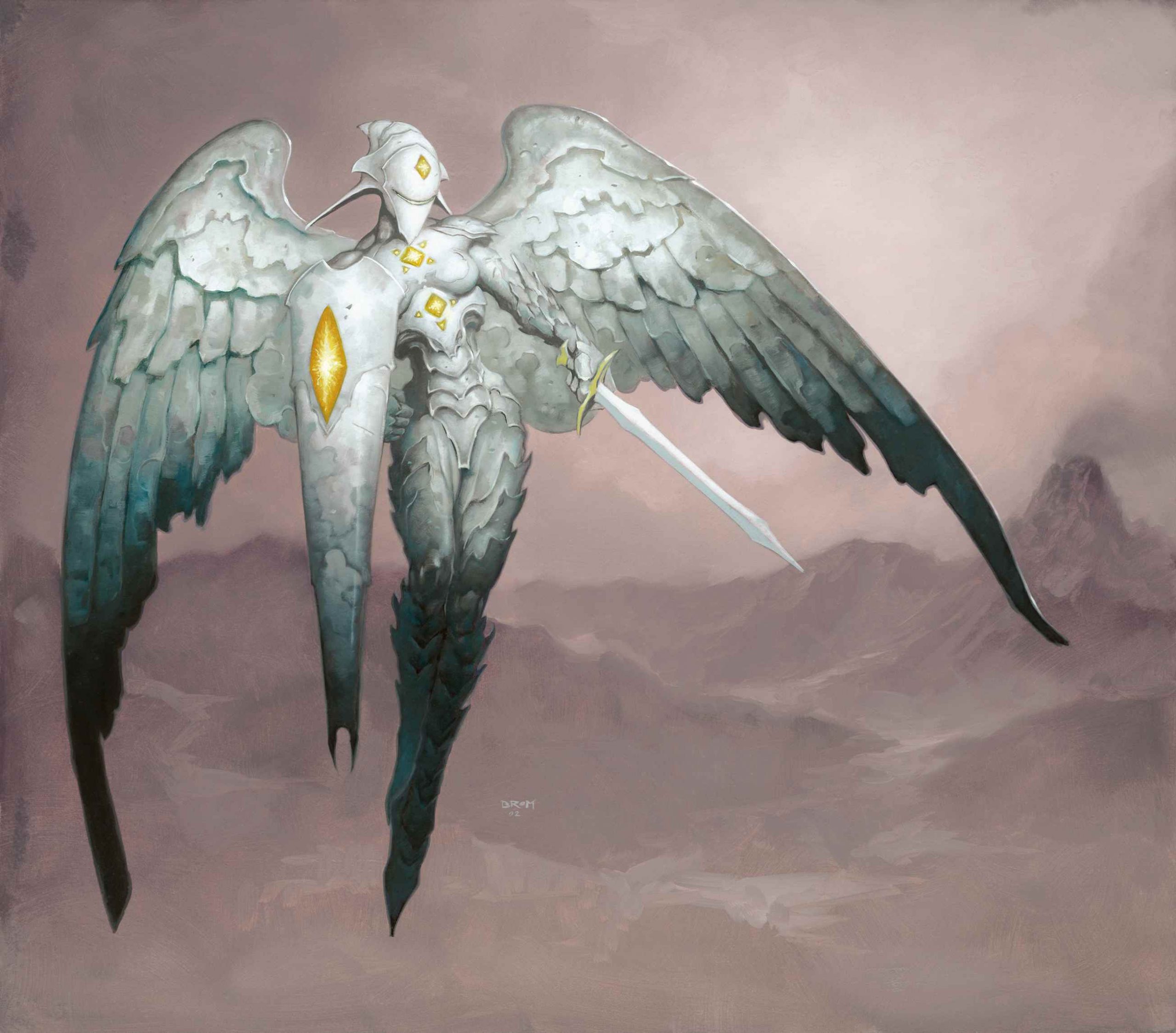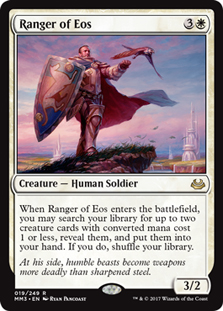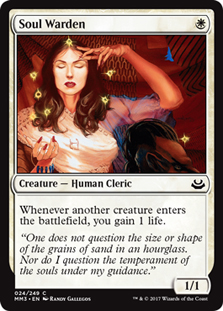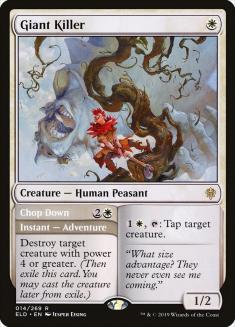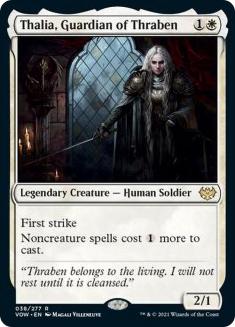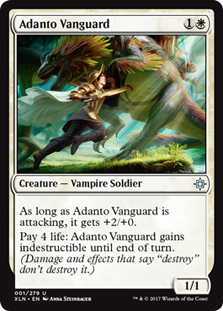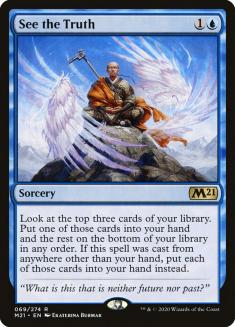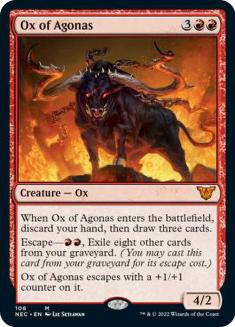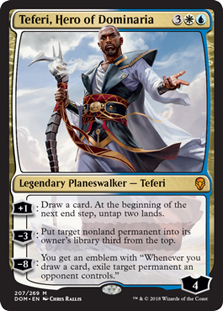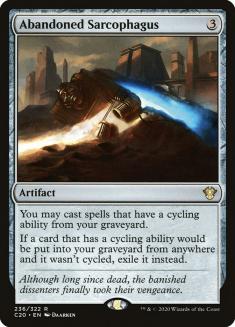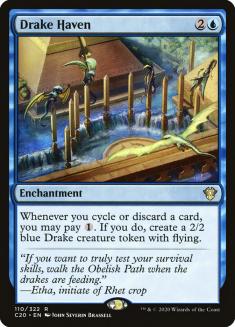First they took our Nexus of Fates, then our Wilderness Reclamations, and now our Field of the Deads. When wondering what Historic was going to look like, my first thought was wondering what the next best ramp strategy would be.
Ugin, the Spirit Dragon isn’t good enough against most opponents, so I don’t think that’ll be it. Nissa, Who Shakes the World and Hydroid Krasis are still there but they mostly have the same problem. I’m certainly not afraid of opponents who want to ramp into Approach of the Second Sun.
So, wait. No ramp deck? No oppressive big mana deck to oppress the fair decks? Let’s get brewing!
Creatures (2)
Planeswalkers (5)
Lands (24)
Spells (29)
- 4 Opt
- 4 Pact of Negation
- 1 Timely Reinforcements
- 4 Chance for Glory
- 4 The Birth of Meletis
- 4 Shark Typhoon
- 4 Fire Prophecy
- 4 Transmogrify
Sideboard

This deck is pretty bad and I wouldn’t recommend it. Michael Majors didn’t want to spend his wild cards to try it, so I did him a solid and blew all mine.
I’d like them back.
Thankfully, this is the type of deck that will only get better over time. It’s already close but the problem lies in its inconsistencies. If you draw Gideon of the Trials and a couple of Pact of Negations, you could get very far ahead of your opponent. Unfortunately, there’s not a great way to recoup your hand once you’ve spent all your resources. Since this deck isn’t putting enough pressure on your opponent, it’s difficult to capitalize.
Pact of Negation is the reason this deck is able to function and I’d play ten copies if I could. Unfortunately, you can’t do that, and most games you end up needing multiples in order to do something more powerful than your opponent.
Once my Gideon of the Trials got killed very easily by a Bonecrusher Giant, my regret truly sunk in.
Majors has allegedly fixed the deck but I don’t believe him.
Creatures (2)
Planeswalkers (9)
Lands (35)
Spells (34)

We want more Pact of Negations, not fewer!
Creatures (30)
- 4 Soul Warden
- 4 Ranger of Eos
- 2 Serra Ascendant
- 4 Ajani's Pridemate
- 1 Mikaeus, the Lunarch
- 3 Thalia, Guardian of Thraben
- 1 Giant Killer
- 1 Linden, the Steadfast Queen
- 3 Daxos, Blessed by the Sun
- 4 Heliod, Sun-Crowned
- 1 Alseid of Life's Bounty
- 1 Selfless Savior
- 1 Speaker of the Heavens
Lands (24)
Spells (6)

I’ve had a weird obsession with Ranger of Eos into Soul Warden since they were dropped into Historic. Ground creatures without evasion are playable again and there are more than a few aggro decks in the format, so I figured I’d give it another shot.
Honestly, it’s not bad. Your powerful draws are loaded with synergy and allow you to quickly build a huge battlefield presence. Wrath of God and the like are issues but Heliod, Sun-Crowned; Ranger of Eos; and Gideon Blackblade out of the sideboard give you some insurance. Unfortunately, piles of removal can be a nightmare.
Ranger of Eos has a nice kit in Historic. You can cut the majority of your interaction because Giant Killer takes care of most of the scary creatures like Elder Gargaroth. There are still Rampaging Ferocidon, Mayhem Devil, and the like, so you can’t cut all the interaction, but it makes it much easier.
Speaker of the Heavens; Serra Ascendant; and Mikaeus, the Lunarch give you ways to break battlefield stalls. Faerie Guidemother could sneak a large Ajani’s Pridemate through if you wanted. There’s protection for your big threats and insulation from sweepers in Selfless Savior and Alseid of Life’s Bounty. Most of the time, you’ll be grabbing a Soul Warden because of how integral to your engine she is.
It’s debatable which white one-drops we’d want to play if we didn’t have Ranger of Eos, so instead, we just get to play them all.
This type of deck feels a half-turn too slow. Something like Venerated Loxodon would help but we’d have to lower our mana curve. There’s a reasonable amount of legendaries in the deck, so what about Mox Amber?
What about both?
Creatures (33)
- 4 Isamaru, Hound of Konda
- 4 Rhys the Redeemed
- 4 Ranger of Eos
- 1 Mikaeus, the Lunarch
- 4 Thalia, Guardian of Thraben
- 3 Skymarcher Aspirant
- 4 Benalish Marshal
- 4 Venerated Loxodon
- 2 Tomik, Distinguished Advokist
- 1 Faerie Guidemother
- 1 Giant Killer
- 1 Selfless Savior
Lands (19)
Spells (8)
Sideboard

WTB Thraben Inspector.
I tried the lifegain package but was happier having aggressive creatures and trying to pump them. Despite losing Heliod, you’re not actually worse against Wrath of God because of the additional clock. Having Thalia, Guardian of Thraben to delay their sweeper by a turn is more likely to matter when you have additional power on the battlefield. Plus, the two-drop slot was getting crowded due to a need for legendary creatures and Ajani’s Pridemate mostly stinks anyway.
Honestly, this deck might be much worse without Adanto Vanguard. I could see Ajani, Adversary of Tyrants as a stronger four-drop than Ranger of Eos but it doesn’t play well with Thalia. There’s also consideration to playing Gideon Blackblade maindeck over Benalish Marshal but it has the same awkward interaction with Thalia. Cedric, help!
Creatures (12)
Lands (21)
Spells (27)

Finally, my actual wheelhouse.
Historic’s card pool isn’t too dissimilar to old Standard’s, so this decklist isn’t too far off from those lists. Lightning Axe is a strong pickup though. Izzet Phoenix is at its best when it’s casting multiple one-mana spells and that matters even more with Young Pyromancer in the mix.
The biggest upgrades are from See the Truth and Ox of Agonas, both of which provide significant card advantage. You can treat either like additional copies of Arclight Phoenix, happy to chill in the graveyard waiting to matter. Finale of Promise was already one of the strongest cards in the deck but it’s incredible when it’s casting Ancestral Recall. Trying to balance the correct count on instants and sorceries for Finale of Promise brings back memories.
Although it pains me to say it, Sprite Dragon might be stronger than Young Pyromancer. Goblin Chainwhirler isn’t heavily played but Rampaging Ferocidon is, plus there’s no shortage of cheap removal. In a creature-heavy format, the Elemental tokens rarely get through for damage and many things have evasion, so they aren’t great at blocking. On the other hand, Sprite Dragon kills people quickly.
I also looked at Mono-Red and Rakdos versions but couldn’t find a real payoff for being hellbent aside from Ox of Agonas. Thankfully, it’s a good one.
Creatures (11)
Lands (22)
Spells (27)
- 2 Shock
- 3 Innocent Blood
- 2 Lightning Axe
- 4 Thoughtseize
- 4 Crash Through
- 3 Finale of Promise
- 4 Thrill of Possibility
- 3 Cling to Dust
- 2 Village Rites
Sideboard

This shell is likely worse than Izzet but it has relevant disruption in Thoughtseize, which could be meaningful in certain metagames. Whereas Izzet has Crackling Drake to deal with things like Rest in Peace, Rakdos has Rotting Regisaur and Hazoret the Fervent. Aside from the discard, I’m happier with Izzet.
Oddly, Rakdos has a higher concentration of one-drops, which makes your Arclight Phoenixes easier to return. Since black lacks the raw filtering power, you probably won’t be able to return Phoenixes every turn like Izzet can. If you have Young Pyromancer, Village Rites helps, but it’s probably too inconsistent to be worth it without other sacrificial fodder.
This shell made me wonder if we could do something with Unburial Rites instead. There are many different ways of filtering or milling cards, but the right creature to Unburial Rites doesn’t appear to be there. Young Pyromancer and Craterhoof Behemoth would be cute when it works but you’re probably winning with tokens and any big threat.
Planeswalkers (4)
Lands (25)
Spells (31)

This is the best way to build Azorius Control and don’t let anyone tell you differently. This deck is also very, very good and the main takeaway should be that Pact of Negation and expensive threats are a potent combination.
My specific numbers are up for debate but Shark Typhoon and Teferi, Hero of Dominaria are the correct end-game. Playing Approach of the Second Sun has been (and likely always will be) a mistake. Sphinx’s Revelation isn’t great but it does usually win the game and the extra lifegain is nice.
You won’t have any issues finding a win condition except against other pure control decks. Maybe something needs to be done about that but I also see spots where I spewed off a Shark Typhoon for minimal value and should have saved it. I could also see wanting to cast Shark Typhoon since Azorius doesn’t have any true way of dealing with it outside of countering it. Even if they use Cast Out or Teferi to get rid of it, it’s only temporary, so that might be my plan going forward.
You need a certain amount of basic lands for Field of Ruin and The Birth of Meletis but I could see adding more Castle Ardenvales in lieu of some multicolor lands. A Commit // Memory could also help, maybe instead of Blink of an Eye, but that probably only puts you on parity and you’ll run into the same issues again.
The numbers are still up for debate but there’s really no need for Approach of the Second Sun. If you insist on playing Approach, I recommend Mind Stone. At that point, you should probably be splashing for Growth Spiral and Uro, Titan of Nature’s Wrath. That would allow you to ramp into your win condition and mostly ignore what your opponent is doing instead of having to play a bunch of spot removal to slow the game down.
Opt is a great card and you’d have to do a lot to convince me not to play it. In this case, you have so many cycling cards that your mana is often tied up anyway. I’m splitting Wrath of God and Settle the Wreckage because Settle works better with Teferi. Realistically, Wrath of God is probably the better card.
Creatures (4)
Lands (26)
Spells (30)

You could splash for Zenith Flare and Deafening Clarion, which is what I set out to do initially, but it’s not necessary. Abandoned Sarcophagus is all the end-game you’ll need, even if it takes a little longer to actually win the game. Drake Haven is cute but it’s usually not necessary and makes more sense as a sideboard threat.
Normally, Azorius Control gains small incremental advantages and wins by casting powerful effects like Wrath of God or Teferi. Azorius Cycling operates on a leaner axis, similarly to how a Dimir Control deck would. They usually don’t have access to catch-alls. Instead, you should be playing a velocity-fueled game where you’re able to find the perfect answer in time. Eventually, Abandoned Sarcophagus will lock up the game.
For as good as Azorius Control is, Azorius Cycling has the potential to be even better. You’re somewhat limited by the cards you get to play, but they are mostly cards you want to be playing anyway. The cycling payoffs, like Flourishing Fox, Abandoned Sarcophagus, and Drake Haven, can be incredible.
The main thing to pay attention to when constructing a deck full of cycling cards is how many cards without cycling you can afford to play. One of the main ways you lose is by cycling a ton of cards and ending up mana-flooded or stuck with cards that don’t cycle like Wrath of God and Seal Away.
Thankfully, we have the additional cycling lands to help mitigate that, although I’m still not certain what the correct number is.
Creatures (6)
Lands (24)
Spells (30)

Whereas Azorius Control is mostly about finesse, all Dimir Control wants to do is jam The Scarab God and protect it. Awkwardly, that plan doesn’t do much in the pseudo-mirrors, but it could be stronger against the rest of the field. In mirror matches, you can happily sideboard out The Scarab God and try to win in some other fashion.
If you have enough time, you can eventually invalidate almost everything your Azorius Control opponent is doing. Arguel’s Blood Fast can give you a massive lead in card advantage and become a way to protect your God from spot removal. Obviously there’s going to be a strange Field of Ruin dance involved but I’m confident you can win that fight if it comes to it.
Of these decks, Azorius Control definitely seems the strongest but Historic is a format that comes at you from multiple angles. Do nothing control decks probably won’t be on top for long. There are also plenty of exciting cards to explore. For now at least, Historic is stable, fun, and interesting.

